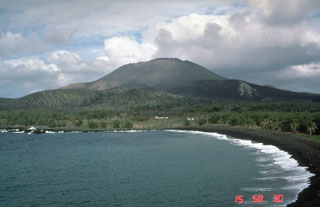Report on Pagan (United States) — 1 September-7 September 2021
Smithsonian Institution / US Geological Survey
Weekly Volcanic Activity Report, 1 September-7 September 2021
Managing Editor: Sally Sennert.
Please cite this report as:
Global Volcanism Program, 2021. Report on Pagan (United States) (Sennert, S, ed.). Weekly Volcanic Activity Report, 1 September-7 September 2021. Smithsonian Institution and US Geological Survey.
Pagan
United States
18.13°N, 145.8°E; summit elev. 570 m
All times are local (unless otherwise noted)
Continuous gas-and-ash plumes from Pagan were observed in satellite images for most of 1 September, prompting the USGS to raise the Aviation Color Code and the Volcano Alert Level remained at Orange/Watch, respectively. The plumes drifted 150 km NW and SW at an altitude of 3 km (10,000 ft) a.s.l. The emissions briefly paused at 2300 and then resumed; satellite images acquired the next morning, on 2 September, showed gas-and-ash plumes drifting 650 km. A plume of ash and sulfur dioxide was identified in satellite data, drifting 150 km W at an altitude of 1.2 km (4,000 ft) a.s.l. early on 3 September. Ash deposits in and around the crater and on downwind parts of the island were observed in 4 September images. During 4-6 September gas-and-ash plumes rose to 1.5 km (5,000 ft) a.s.l. and drifted at least 400 km W. Sulfur dioxide emissions were observed in satellite data on 6 September; ash emissions paused sometimes during 6-7 September as activity declined. A robust steam plume possibly containing a minor amount of ash was visible in satellite data on 7 September drifting 24 km W at an altitude of 1.5 km (5,000 ft) a.s.l.
Geological Summary. Pagan Island, the largest and one of the most active of the Mariana Islands volcanoes, consists of two stratovolcanoes connected by a narrow isthmus. Both North and South Pagan stratovolcanoes were constructed within calderas, 7 and 4 km in diameter, respectively. North Pagan at the NE end of the island rises above the flat floor of the northern caldera, which may have formed less than 1,000 years ago. South Pagan is a stratovolcano with an elongated summit containing four distinct craters. Almost all of the recorded eruptions, which date back to the 17th century, have originated from North Pagan. The largest eruption during historical time took place in 1981 and prompted the evacuation of the sparsely populated island.
Source: US Geological Survey

